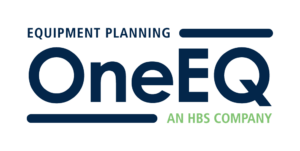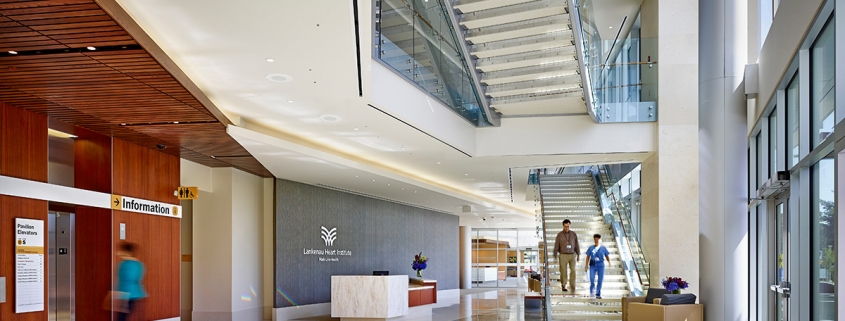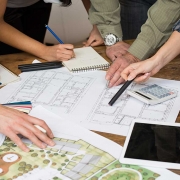HCAHPS Scores—The Link to Equipment Planning and Healthcare Design
Hospital reimbursement rates are increasingly based on outcomes and the patient experience, as measured by the HCAHPS survey. OneEQ’s Jeff Davis explains how the right equipment planning and design can make all the difference.
Ever since the Affordable Care Act made hospitals dependent on the Hospital Consumer Assessment of Healthcare Providers and Systems (HCAHPS) survey for full reimbursement, healthcare organizations have started thinking about new ways to enhance the patient experience.
Not everyone has been happy about this shift, but, regardless, patient experience has always been a core part of clinical philosophy. As new research and evidence comes out, and HCAHPS scores provide insight into how patients are experiencing the healthcare environment, the best design and planning strategies that can improve that experience are rising to the top. In fact, U.S. News recently updated their method for scoring the best specialty hospitals, incorporating HCAHPS scores and putting a stronger emphasis on the patient experience.
And lest you think that higher survey scores are only meaningful on paper, the truth is that increasing HCAHPS scores can have a two-fold financial benefit. First, with hospital scores now in the public domain, patients can be savvy healthcare consumers and choose healthcare institutions with the best patient experience. Clearly, more patients means higher revenue. Second, the scores translate directly into dollars, with a portion of Medicare and Medicaid reimbursements tied to the HCAHPS survey; hospitals that perform better than the median in their region are rewarded with higher reimbursement rates and lower performing hospitals are penalized. In turn, private payers typically base their reimbursements or contracted rates on Medicare reimbursements, so it’s easy to see that improving HCAHPS scores is becoming a financial imperative to most institutions.
The survey itself only takes a few minutes for patients to complete and the questions fall into three categories—staff communication and responsiveness; cleanliness and quiet; and overall patient experience. The right equipment planning and design can make a big difference in moving the needle from a mediocre patient experience to an excellent one.
Staff Communication and Responsiveness
More than half of the questions on the 32-question survey fall into this category and they’re all about how patients feel that they’re treated by nurses, physicians and other staff—were they respectful? Did they explain medications and instructions in a clear way? Did they listen carefully? And did the patient understand everything? Clearly, these questions can depend a lot on the personalities involved, but that doesn’t mean that design can’t play a role in improving scores to these questions.
The physical environment can certainly affect staff and how engaged they are with patients and designers can use a number of strategies to enhance well-being.
Specific material selections can reduce noise and absorb the impact of a 12+ hour shift. Then there’s the design program for the hospital, which should include space for staff and outdoor areas for both patients and staff, which has been shown to help with healing. The quality of staff “off stage” areas can make a major difference, giving nurses and physicians social spaces to interact, but also quiet, private areas to process some of the inevitably overwhelming emotions that come with the job.
Including staff in hospital initiatives, the hospital planning process and addressing their feedback early on can help ensure that staff are getting the resources they need to exceed patient expectations.
The HCAHPS survey also asks if staff explained medication and recovery instructions properly with the goal of shortening healing time and reducing errors in combining medications and other complications. Good communication is part of the culture of a health organization—doctors used to sit behind a desk and tell you what you needed to know; these days, they’re more likely to have a laptop and show you a screen with your medications on it, asking you to make sure everything looks right. By including staff in the planning process and addressing their feedback early-on, designers and equipment planners can create the best physical environment to help hospital staff communicate with their patients on an equal level, encouraging patients to feel more involved in their own healing process.
Cleanliness and Quiet
It may be easiest to see how design and equipment planning can improve scores on survey questions about quiet and cleanliness, since they relate directly to the built environment. Indeed, if a designer has a proven strategy to make a facility cleaner and quieter, hospitals are likely to listen, especially because the biggest complaint on the HCAHPS survey is about noise in the hospital.
There are plenty of materials that can help, like special floors, soft-close doors and drawers, and ceiling panels that can reduce noise. There are engineering solutions like triple demising walls and double-layered flooring. Designers and planners can even change the layout of a hospital unit to carry less noise. Hospitals can encourage quiet by using lights that are programmed to dim during quiet hours in the afternoon, and equipment with lights that change color as noise levels increase so that staff and visitors get a visual cue that they’re being too loud.
The other component of this section of the survey, cleanliness, is really asking about the patient’s perception of how clean their room and bathroom were, but hospitals have other reasons to focus on cleanliness; under ACA rules, if a patient contracts a secondary infection while in the hospital, the hospital isn’t reimbursed for the patient’s stay while they recover from that infection.
We all tend to think of cleanliness as a housekeeping issue—things like easily cleanable, antimicrobial materials and finishes. But cleanliness is also a clutter issue; if there isn’t adequate storage for equipment and supplies, it makes people think it’s messy, even if it might be germ-free, which speaks directly to equipment planning, layout and overall design.
As equipment planners, our OneEQ team works with designers to create room mock-ups and prototypes. We have clinical staff go through these prototypes and provide feedback as they go along. Added to that, we combine our own research, industry trends and our 30 years of experience to buy the best possible equipment for a given situation and place it to reduce clutter, increase hygiene and, consequently, enhance the patient experience and increase HCAHPS scores.
Overall Experience and Recommendations
There are only two questions under this category: 1) Using any number from 0 to 10, where 0 is the worst hospital possible and 10 is the best hospital possible, what number would you use to rate this hospital during your stay? And 2) Would you recommend this hospital to your friends and family?
These two overview questions give the most substantial insight into the patient experience. It’s really about what we remember. If any of us walk away from a hospital with a good feeling, even if we can’t necessarily pinpoint an aspect of the design strategy that made us feel good, we’re more likely to give a positive review of the institution.
Clearly, if a patient feels that they were well cared for by nurses and doctors, and that the hospital was clean and quiet, they’re going to have a pretty positive impression. But there are other things that can help push them into a positive mindset. Some hospitals are creating special toolkits for patients that are having trouble sleeping with an eye mask, ear plugs and calming essential oils—these amenities may help with insomnia to be sure, but it’s also just one more opportunity for nurses and doctors to show patients that they care and understand what the patient is dealing with.
The Final Score
As the political winds shift and the Affordable Care Act goes through changes, the HCAHPS survey continues to have a great deal of influence on how hospitals operate and how they are reimbursed by both public and private payers. By using equipment planning and design strategies to increase HCAHPS scores, healthcare organizations and clinicians will necessarily improve patient experiences and enhance health outcomes, increasing their reimbursement rates in the process.

Jeff Davis takes a pragmatic, no nonsense approach to everything he does—from project planning through equipment selection and purchasing as well as project activation and clinical analysis. Whether new construction or renovation, a 1.2MSF replacement hospital or a cardiac cath unit, Jeff brings it home.



